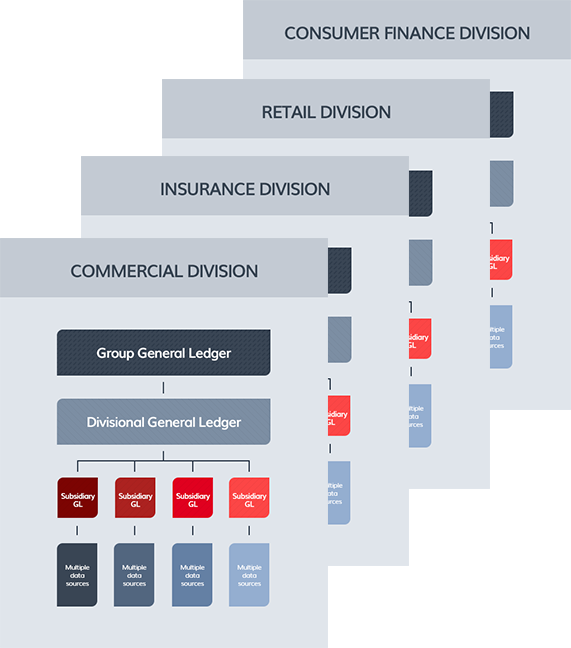Top 5 UK Bank reduces cost and complexity by progressively transforming finance with a scalable platform.
Learn moreAbout our client
One of the oldest retail and commercial banks in the UK.
The bank had experienced growth through acquisition and through their commitment to customers and the communities they serve.
In order to continue serving stakeholders, they needed to streamline the Finance IT architecture to simplify operations, control costs and increase control over data and accounting.

The Mission
For the Bank’s Head of Finance Business Architecture, the question was:
“ How do we transform systems to enhance accounting functionality while reducing costs? ”
- Reduce duplicated systems & reliance on legacy technologies.
- Shorten and simplify business processes & touch points.
- Standardize operating models & multiple charts of accounts.
- Reduce the operational cost of exceptions.
- Address challenging accounting tasks like accommodating post-close adjusting entries, systemizing manual recurring journal entries and automating account reconciliations & consolidations.
- Reduce IT & process complexity to allow for increased off-shore support & development functions.
- Support an eventual move to a cloud-based General Ledger.
When the financial crisis started in 2008, people treated it like a triage situation and problems were solved in slices. Since then, banks have used different solutions with different data stacks. Architectures have aged to the point where they need to be fixed. So the question is ‘How do we consolidate all of these patches in a way that progresses our existing business architecture?’ There has to be a moment of reckoning in how we consolidate and have more sustainable solutions.
To achieve their goals, he envisioned a solution that could grow with the Bank
During the evaluation phase, three key themes came to the forefront:
-
Simple

Simple
The solution had to fit within a company-wide ’simplification effort’ to significantly standardize operational processes and data across bank businesses and projects.
-
Strategic

Strategic
They wanted a flexible platform that could start by addressing existing divisional projects and grow into a company-wide solution.
-
Scalable

Scalable
The solution had to handle low and extremely high volume projects equally well.
Aptitude Software
was selected against an incumbent large technology player to standardize accounting policy and increase financial control and transparency.

The Challenge
Like many banks, the organization had several divisions, each with multiple brands or subsidiaries underneath.
A typical divisional architecture had multiple, disparate data sources feeding the subsidiary GLs. These GLs would in turn be summarized up to a divisional level before ultimately rolling up to a Group General Ledger.
Duplicated systems, legacy technologies and lack of standardization across divisions made operations expensive and time consuming. The Bank also lacked a single, company-wide version of “financial truth”.


A complex, legacy-heavy architecture posed the followings issues:
- Multiple technologies, interfaces and modifications required to connect transaction systems with the Group GL and Data Warehouses
- Inability to drill down from summarized balances to transaction level detail resulting in lack of auditability and costly compliance efforts
- No technology standardization across subsidiaries means increased complexity and higher cost & resource requirements
- Significant manual reconciliation required
- Lack of centralized accounting
Driving Results
The Bank is using Aptitude Software technology solutions to drive benefits across the organization
-
Simple

Simple
- Out-of-the-box, banking-specific accounting templates simplify implementation and reduce risk
- Single Sub-Ledger platform serves as consolidation point for granular information and accounting logic
- Simplifies accounting by accomodating post-close adjusting entries, automation account reconciliations and standardizing multiple Charts of Accounts
-
Strategic

Strategic
- Supports rationalization of multiple ledgers towards a thin, Group GL structure
- Flexible environment allows the bank to respond to changing market, reporting and regulatory demands
- Gain economies of scale in training, implementation, operations and support
-
Scalable

Scalable
- Optimizes hardware platform utilization while reducing duplicated and legacy technologies
- Meets expected levels of future expansion
- Removes IT resource bottleneck by allowing finance increased ownership
The Projects
By identifying and executing divisional level projects, the Finance Architecture team is progressively transforming finance.
Retail Division
The Aptitude Platform integrates, standardizes and enriches data from over 80 transaction and summary accounting feeds from division subsidiaries into the divisional General Ledger.
Consumer Finance Division
The Aptitude Accounting Hub allows the Consumer Finance Division to consolidate multiple General Ledgers across divisional subsidiaries to directly feed the Group General Ledger.
Commercial Finance Trading Arm
The Aptitude Platform uses flexible business rules, controlled by finance, to process and consolidate over 1 Million open trades per day.
Future projects are in flight across the organization to continue to help the bank simplify, standardize finance operations and move to a Cloud General Ledger.
A Platform to grow with: Simple, Strategic, Scalable
Our finance expertise and accounting integration heritage from over 18 years of activity in the International Banking sector made us the ideal partner of choice to support the dynamic development of the bank.
With Aptitude Software, they gain a flexible and cost-effective platform to progressively transform finance.
